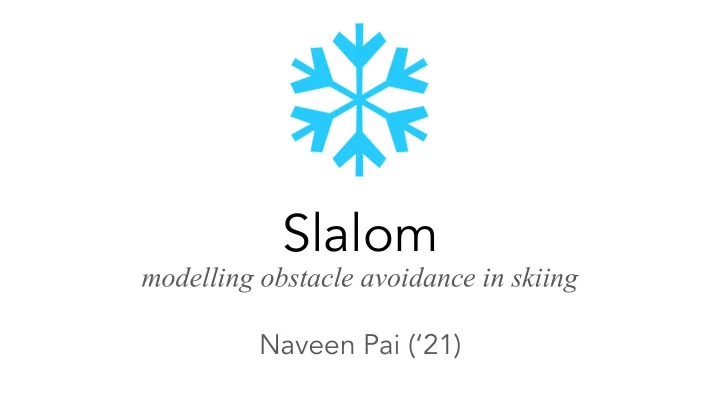

Slalom modelling obstacle avoidance in skiing Naveen Pai (‘21)
Motivation
Properties of skiing ● Can’t rely on braking ● Path consists entirely of turns ● Navigate anticipated obstacles
Applications brake failure!
The Model...
The Course
Skier’s motion ● circular motion ● rotational direction ● control turning radius ● constant velocity
First proof ● skier stays in bounds ● skier maintains safe turning radius ● circular motion is respected
Controller is too lazy...
How about time triggered control? IDEA ● controller wakes up at least every T seconds PROBLEMS ● frequent control adjustment isn’t helpful ● loses control of when to turn ● deciding path relies on π, can’t ski in a straight line
Event triggered control (reloaded) ● controller chooses x-coordinate, x turn ● sleeps until x turn is reached ● skier looks down at slope, decides to shift feet at a certain point ● downside: could lead to unrealistically small turns
Second proof ● most difficult step in project ● must reason that y-velocity stays non-negative ○ introduce invariant that involves rotational direction ○ show that ODE’s respect this invariant
Obstacle avoidance approach ● include 3 obstacles in formula ○ difficult to reason about natural numbers in dL ○ however, controller’s approach generalizes ○ proof technique also generalizes ● vertically aligned, evenly spaced
Obstacle avoidance proof ● Restrict obstacle spacing based on course width ● Introduce invariant about center of motion ○ obstacles act as the center of motion ○ turning radius is half the distance between obstacles
Summary: proven properties 1. skier stays in bounds on an inputted course 2. skier never strays uphill 3. skier maintains safe, bounded circular motion 4. skier avoids evenly-spaced, circular obstacles
Recommend
More recommend